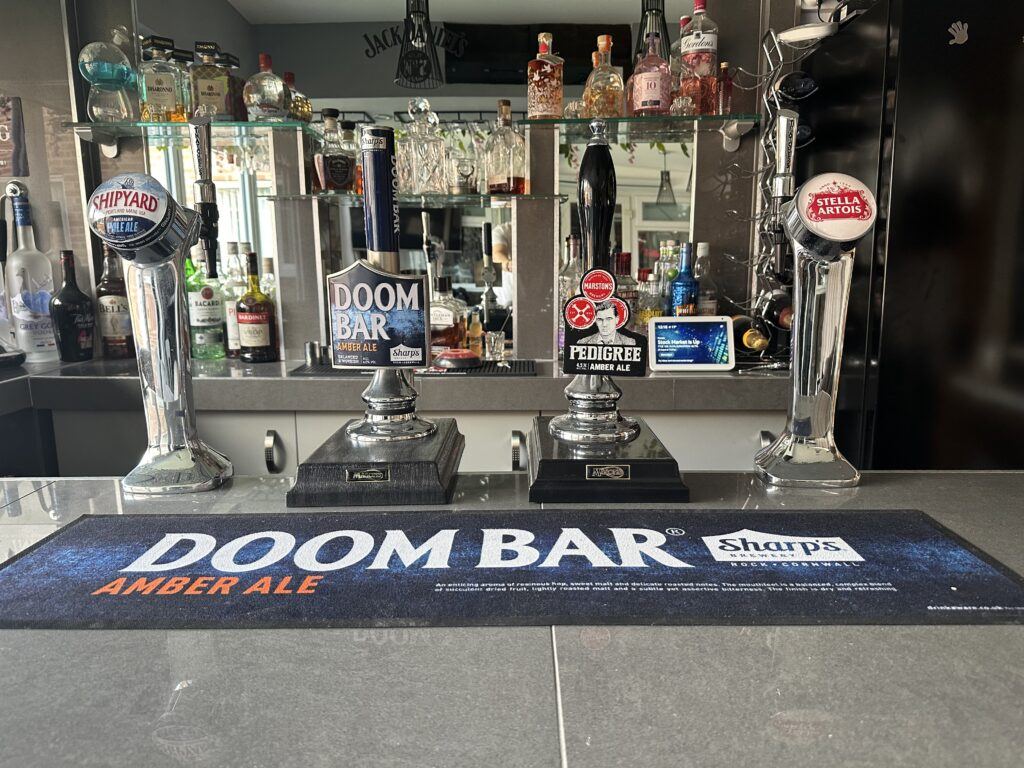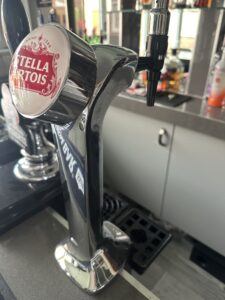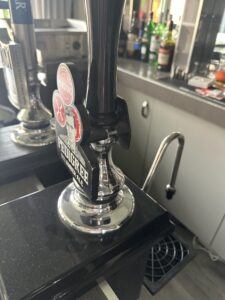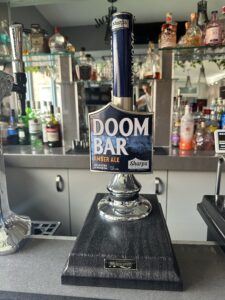
Imagine having pub-quality draught beer right at home. This is where a home bar draught beer pump comes into the picture. These devices can change your beer game from average to professionally brewed quality. Let’s break down why they might be a great addition to your home bar.
First off, having a beer pump can be a real money-saver over time. While the upfront investment might seem steep, think about the regular cost of buying bottled or canned beer. If you’re a frequent beer drinker, those costs add up quickly. A home beer pump can offset these expenses since you can buy beer in bulk, typically at a lower price per pint. It’s a long-term investment in your beer enjoyment.
One of the biggest perks is the quality. Let’s be real, draught beer almost always tastes fresher and smoother than its bottled or canned counterparts. The carbonation and pressure control in these pumps keep the beer in its prime state, ensuring every pour is as good as the one you’d get at your local pub. Plus, there’s something inherently satisfying about pulling the handle and watching that perfect pour.
User experiences speak volumes. Many enthusiasts rave about the enhanced flavour and enjoyment of drinking draught beer at home. Real-life testimonials can be very convincing if you’re on the fence. Some people share that they host more gatherings and social events because the draught beer becomes a hit among friends and family.
Of course, it’s essential to weigh the pros and cons. On one hand, you have the initial setup cost, regular maintenance, and space considerations. On the other hand, you’ve got better-tasting beer, potential savings over time, and the sheer fun of having a mini draught system at home. If you love beer and socializing, the investment often pays off in more ways than one.
What Do I Need to Set Up a Beer Pump?
Setting up a home beer pump might seem complicated at first glance, but it’s actually pretty straightforward once you’ve got the essentials down. Here’s a quick rundown on what you’ll need to get started.
First, you’ll need the pump itself. There are various options out there, from hand pumps to more sophisticated electric ones. Your choice depends on your budget and how fancy you want to get. Do some research, read reviews, and pick one that fits your needs.
Next, you’ll need a keg. Think of this as your beer storage. You’ll find kegs of all sizes, so consider your drinking habits and how much beer you plan to serve. Smaller kegs are great for occasional use, while larger ones suit regular or party-centric setups.
A CO2 system is another crucial component. This keeps your beer carbonated and maintains the right pressure. If you’re wondering why this is important, remember that a flat beer is no one’s friend. Kits generally come with a CO2 tank and regulator, making it relatively easy to get started.
Of course, you can’t forget the basics: tubing and connectors. These link your keg to the pump and ensure a smooth flow of beer. They’re usually included in complete kits, but make sure to double-check so you don’t miss any critical pieces.
Time to set it all up! Position your pump, keg, and CO2 system where they’ll be easy to use but out of the way. A cool, dark spot works best to maintain beer quality. Start by connecting the tubing to the keg and the pump, then hook up the CO2 system. It might seem tricky initially, but many setups come with easy-to-follow instructions or video guides.
Maintenance is essential for keeping your system in top-notch condition. Regularly clean your pump, lines, and keg to avoid any unwanted flavors or bacteria buildup. You’ll thank yourself for maintaining it well when every pint tastes amazing.
If you’re wondering which beers to get, here are some crowd-pleasers:
**1. Guinness Draught:** Perfect for lovers of stout, with its smooth, creamy pour.
**2. Heineken Lager:** A crisp and clean choice that’s always a hit.
**3. Sierra Nevada Pale Ale:** Offers a balanced hoppiness that’s easy to enjoy.
**4. Stella Artois:** Known for its premium quality, this lager is a sophisticated pick.
**5. Blue Moon Belgian White:** A refreshing, citrusy option that’s great for any occasion.
How Do Home Beer Pumps Work?
Ever wondered what goes on behind the scenes of your home draught beer setup? Understanding how these pumps work can help you appreciate that fresh, frothy pour even more.
At the heart of it all is carbonation and pressure. When you pour beer from a keg through a pump, the CO2 system keeps the beer carbonated and pushes it out at just the right pressure. This is crucial for maintaining the beer’s freshness and taste. No one likes flat beer, and a properly working pump ensures you’ll never have to deal with that.
Here’s a step-by-step overview of what happens during the beer-pumping process. First, the CO2 gas inside the tank enters the keg, applying pressure on the beer. This pressure forces the beer up through the tube when you pull the handle of the pump. As the beer travels through the lines, it stays cold and fresh, thanks to the controlled environment. The beer flows out of the tap and into your glass, perfectly carbonated and delicious.
Of course, like any device, beer pumps can have their quirks. Common issues include low pressure, which leads to foam instead of beer, or too much pressure, which can cause an overly aggressive pour. Knowing how to tweak the pressure settings on your CO2 system can make a big difference. Simple troubleshooting can usually fix these problems, like checking for leaks in the tubing or ensuring the CO2 tank isn’t empty.
Traditional pumps and modern pumps both have their merits. Traditional hand pumps rely on muscle power and are often favoured by those who appreciate a more hands-on approach. Electric pumps, on the other hand, offer convenience and consistency, making them ideal for frequent use or larger gatherings. Both types deliver that iconic draught experience, just in slightly different ways.
Visual aids can help clarify this process even more. Diagrams or videos showing the internal workings of a beer pump can be incredibly helpful, especially for visual learners. Whether you’re a beer enthusiast or just like to know how things work, understanding this process can make you appreciate each pint a little more.

What Are Bar Pumps Called?
Different beers call for different kinds of pumps. Let’s get into some of the main types you’ll come across.
Hand Pumps, also known as beer engines, are the traditional choice, mainly used for cask ales. They operate manually and give you a real sense of connection to the beer as you pull that handle to draw out a pint.
Electric Pumps are more modern and convenient. They’re great for home setups where you want consistent pours without the physical effort. Just plug them in, set your pressure, and you’re ready to go.
Kegerators combine a refrigerator and beer dispensing system into one unit. They maintain the perfect serving temperature and come in various sizes, fitting into home bars seamlessly.
Understanding the evolution of beer pumps helps you appreciate their role in pub culture. From the early hand-cranked pumps to today’s automated systems, each iteration has brought its own innovations, making it easier to enjoy a perfect pint at home.
Optimizing your pump’s performance involves regular cleaning, checking for leaks, and fine-tuning the pressure settings. These steps ensure that your beer stays fresh and every pour is as good as the last.
Personalizing your home bar setup can make a huge difference. Use decorative tap handles, branded beer mats, and custom kegerator wraps to reflect your style, making your home bar not just functional but also a talking point among friends.
Tricks and Tips for the Best Home Beer Pump Setup
When creating the ultimate home draught experience, a few insider tricks can make all the difference. Here are some tried-and-true tips to get you pouring like a pro.
Temperature is key. Keep your beer and kegs stored at a consistent, cold temperature. Usually, a range between 38-45°F (3-7°C) works best. This keeps the beer fresh and the carbonation just right. Invest in a good-quality thermometer to monitor this.
The right glassware matters. Pouring your beer into a clean glass that’s designed for the type of beer you’re serving can enhance the flavour and aroma. For example, use a pint glass for lagers and ales, or a tulip glass for Belgian styles. Clean glasses ensure you don’t get any unwanted flavours or bubbles affecting your drink.
Master the pour. Start by holding your glass at a 45-degree angle and begin pouring slowly. Gradually straighten the glass as it fills. This technique minimizes foam and ensures a perfect head on your beer.
Regular maintenance keeps your setup in top shape. Clean the lines, kegs, and tap regularly to prevent any buildup that could impact the flavour. Consistent maintenance also prolongs the life of your equipment.
Adjusting the CO2 pressure can fine-tune your beer’s pour and carbonation. If you’re getting too much foam, lower the pressure slightly. If the beer feels flat, increase it. Small tweaks can lead to the perfect pint.
A well-organized setup is both functional and aesthetically pleasing. Consider investing in shelving, branded tap handles, or even some pub-style decor to create the right vibe. Your home bar should be a place you enjoy, both for its looks and its functionality.

